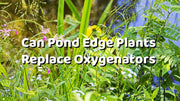
A ripple of water, a stand of reeds, and silver fish gliding just under the surface—your backyard pond already looks alive. But looks can deceive. Beneath that mirror, the invisible gas oxygen powers every breath a fish takes and every beneficial bacterium’s chemical reaction. You’ve read that oxygenating pond plants keep water fresh and clear, and you’re tempted to forget pumps and let nature handle it. Before you yank the cord on your aerator, let’s explore what plants can (and can’t) do, how shoreline vegetation fits into the equation, and why a low-impact backup such as a Poposoap Solar Fountain Pump is still the most reliable insurance policy for a healthy pond.
The Role of Oxygen in Healthy Ponds
Dissolved oxygen is the pond’s bloodstream. Fall below 5 mg/L for several hours and koi gasp at the surface; drop under 2 mg/L and the nitrifying microbes that keep ammonia in check stall out. Warm water holds less oxygen, night respiration consumes what daylight photosynthesis produced, and an unexpected power cut can tip a perfectly balanced pond into crisis by dawn. That’s why every management plan, whether it leans on technology or botany, begins with a single question: how will we keep oxygen levels stable 24/7?
What Are Oxygenating Pond Plants?
You’ll see them sold under many labels—oxygenated plants for ponds, pond oxygenators plants, “submerged aquatics,” or simply “oxygenators.” Hornwort (Ceratophyllum), Canadian waterweed (Elodea canadensis), water violet (Hottonia) and anacharis are the classics. Rootless or lightly anchored, they live completely under water. During daylight, they photosynthesise, releasing tiny streams of O₂ bubbles while taking up excess nutrients. Their foliage offers fry refuge and grazing for algae-eating snails.

Because they sit below the surface, these plants that oxygenate ponds operate even when lilies shade the water or marginal iris crowd the rim. At peak growth, a dense planting can add two to three milligrams of oxygen per litre each sunny afternoon—enough to offset moderate fish stocking in ponds up to about 400 gallons.
Can Edge Plants Oxygenate Effectively?
Shoreline species—sweet flag, dwarf cattail, pickerelweed—are indispensable for filtration and erosion control, but their stems spend most of the day in the air, not under water. The submerged portions perform limited gas exchange. Photosynthetic leaves above the surface release oxygen straight into the atmosphere, so the water column doesn’t benefit directly.
Even in shallow zones, roots of edge plants respire (that is, consume oxygen) at night. In natural wetlands, that isn’t a problem because wind and streams continually re-oxygenate vast volumes. In a still garden pond, a thick quarantine of marginal plants can actually lower predawn dissolved-oxygen if no mechanical backup is running. Bottom line: edge vegetation plays a supporting role, not a replacement, for true oxygenating plants for a pond.
Best Oxygenating Pond Plants (and Where to Place Them)
- Hornwort floats freely, so you can tuck strands among lily pots where fish won’t shred them. Because it overwinters under ice, hornwort is ideal for zones that hit hard freezes.

- Anacharis (Egeria densa) roots loosely in gravel; plant it in bunches along the mid-shelf (12–18 inches). It keeps algae down by competing for nutrients and remains green through winter in zones 7-10.
- Water thyme (Hydrilla verticillata) grows fast, sometimes too fast—keep only a few bunches unless you have grass carp to trim it.

- Water starwort (Callitriche palustris) carpets the shallow rim, linking submerged oxygenation with shoreline cover.

Arrange these best oxygen plants for ponds like a layered forest—tall oxygenators in the central bowl, carpeting species on shelves, emergent plants around the rim. That mosaic maximises oxygen production and gives wildlife corridors through every depth.
Natural Oxygen Strategy: Plant Layout vs. Mechanical Aeration
Photosynthetic oxygen is free, silent, and carbon-negative, but it has two critical limitations:
- It shuts off at night. Respiration continues, so net oxygen drops for 10–12 hours.
- It depends on clear sunlight. A week of overcast—just when warm weather spikes fish metabolism—can starve the system.
Mechanical aeration is the mirror-image: it works in darkness and bad weather but costs energy. The smart compromise is a hybrid design:
- Blanket 40–60 percent of the pond’s footprint with submerged oxygenators.
- Use marginal plants primarily for filtration and habitat.
- Run a small, energy-miser backup such as the Poposoap 10-Watt Solar Fountain Pump on all sunny days; its brushless motor sips power yet lifts a sparkling umbrella spray that circulates and oxygenates without blasting tadpoles against the liner.
- At night or during storms switch to a battery-assisted Poposoap Floating Pond Fountain or a compact Poposoap Solar Pond Aerator—both function autonomously, turning on the moment panel voltage falls.
Because Poposoap’s equipment is cord-free and low voltage, it keeps the natural aesthetic intact: no bright cables threading the garden, no hum of an oversized blower.
Tips for Boosting Pond Oxygen Naturally
(Add a Poposoap solar fountain or waterfall kit for backup)
- Prune heavily in mid-summer. Dead or decaying stems reverse the oxygen equation by decomposing. A quick haircut keeps growth lush and productive.
- Thin floating-leaf coverage to 65 percent or less. Lilies are beautiful but shade oxygenators; leave lanes where sunlight penetrates to the depths.
- Add vertical movement. Even a trickle—think the Poposoap Pond Waterfall Kit spilling 8 inches into a pool—creates a wide gas-exchange surface. Position the return opposite the main pump outlet so currents sweep the entire floor.
- Use porous substrate. Plant oxygenators in coarse pea gravel, not dense soil, so water can flow around roots and distribute the O₂ they release.
- Avoid over-stocking fish. Rule of thumb: one inch of goldfish per five gallons when relying primarily on plant aeration. Mechanical systems can double that capacity.
- Keep filters humming. A Poposoap Solar Pond Filter with built-in bio-balls houses trillions of bacteria that also need oxygen. Good flow through the box ensures plants aren’t carrying the load alone.
- Monitor at dawn. Test kits or a simple electronic DO meter tell the truth. If readings dip below 5 mg/L more than twice a week, add more circulation or prune biomass.
Follow those steps and your mix of oxygenating pond plants and whisper-quiet solar hardware will handle every seasonal swing short of a full-week heatwave.
Conclusion: Plants Can Help, But Balance Is Key
Edge flora filter runoff, stabilise banks, and compose the painterly frame of a pond, yet they are not a substitute for submerged oxygenating plants for a pond—and certainly not for guaranteed aeration on windless August nights. Build your system on three pillars:

- Core oxygenators in the water column,
- Thoughtful marginal plantings for beauty and nutrient uptake,
- A minimalist mechanical backup such as a Poposoap solar fountain, aerator, or waterfall kit for the hours plants go off duty.
That trio mirrors nature itself: photosynthesis by day, gentle wave action by breeze or spring by night. Poposoap’s mission—helping pond keepers “bring beauty and joy into life with stunning water features while protecting the world we share”—finds its perfect expression here: harness sunlight, add movement, and let living green do the rest. Your fish will thrive, your water will sparkle, and you’ll know the pond is breathing easy around the clock.







